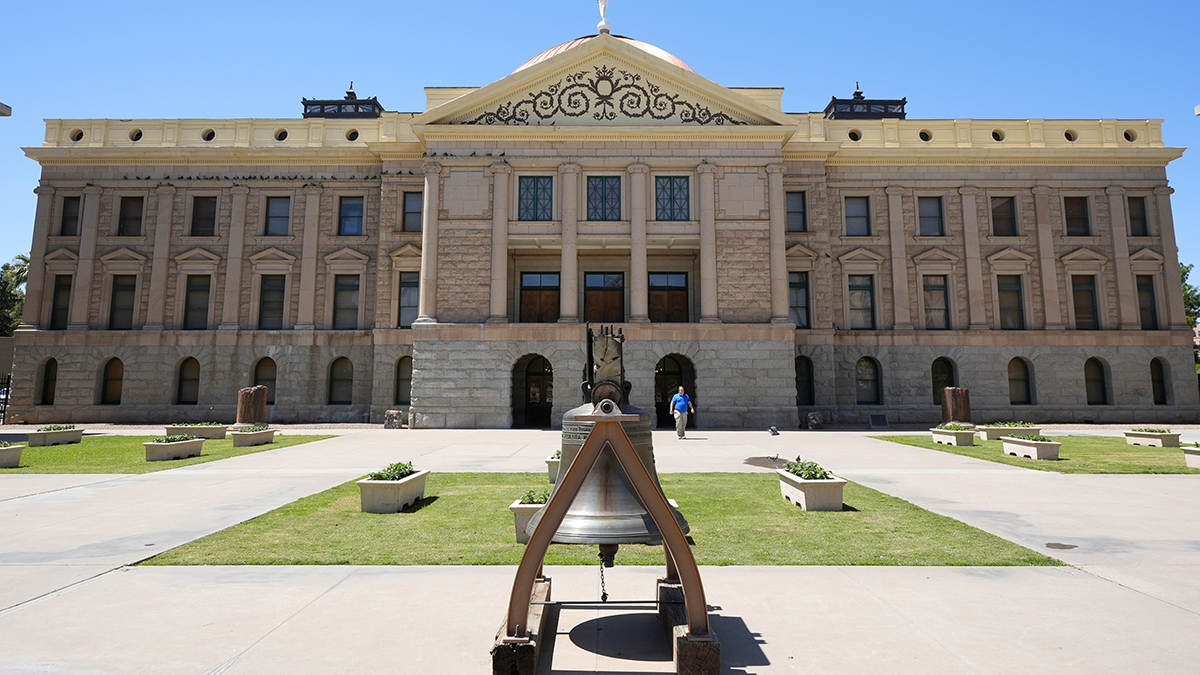
A plan announced last month by President Joe Biden offers student debt relief to millions of Americans, though not everybody with student debt is eligible.
According to the White House, more than 40 million Americans are eligible for student debt relief under the plan, with almost 20 million borrowers eligible to have their student debt entirely wiped out.
With the plan impacting millions of people, many are wondering how many people in each state are benefiting from the debt forgiveness. The Biden administration's plan cancels $10,000 of debt for recipients of standard loans and up to $20,000 in forgiveness for Pell Grant recipients.
Only borrowers who make less than $125,000 a year or families who make less than $250,000 a year are eligible for the relief.
Feeling out of the loop? We'll catch you up on the Chicago news you need to know. Sign up for the weekly Chicago Catch-Up newsletter here.
Illinois ranks in the top 10 for both overall eligible borrowers and Pell Grant recipients, as nearly 1.5 million Illinois residents are eligible for some student debt relief. According to the White House, well over 863,000 Pell Grant recipients in Illinois are also eligible for additional relief.
Below is a list of estimations released by The White House on how many Americans will benefit from the relief in each state and U.S. territory.
| State or Jurisdiction | Estimated Number of Borrowers Eligible for Student Debt Relief (rounded to the nearest hundred) | Estimated Number of Pell Borrowers Eligible for Student Debt Relief (rounded to the nearest hundred) |
| AK | 60,500 | 37,300 |
| AL | 588,000 | 404,900 |
| AR | 365,600 | 269,000 |
| AS | 2,000 | 1,500 |
| AZ | 810,800 | 554,900 |
| CA | 3,549,300 | 2,340,600 |
| CO | 698,100 | 419,000 |
| CT | 454,200 | 238,200 |
| DC | 105,600 | 60,300 |
| DE | 116,900 | 68,000 |
| FL | 2,427,600 | 1,716,300 |
| GA | 1,506,100 | 1,039,100 |
| GU | 6,900 | 4,500 |
| HI | 111,500 | 65,700 |
| IA | 408,700 | 248,900 |
| ID | 201,400 | 144,900 |
| IL | 1,486,600 | 863,600 |
| IN | 856,400 | 555,500 |
| KS | 360,900 | 225,500 |
| KY | 563,300 | 394,000 |
| LA | 608,100 | 435,200 |
| MA | 813,000 | 401,200 |
| MD | 747,100 | 419,400 |
| ME | 175,000 | 105,300 |
| MI | 1,316,000 | 849,300 |
| MN | 729,700 | 416,300 |
| MO | 777,300 | 502,200 |
| MP | 1,400 | 1,000 |
| MS | 417,200 | 316,400 |
| MT | 120,400 | 78,600 |
| NC | 1,190,500 | 785,500 |
| ND | 82,000 | 49,600 |
| NE | 232,100 | 136,000 |
| NH | 175,100 | 85,300 |
| NJ | 1,082,900 | 590,300 |
| NM | 215,900 | 159,000 |
| NV | 315,800 | 216,900 |
| NY | 2,258,800 | 1,320,100 |
| OH | 1,677,800 | 1,085,700 |
| OK | 454,300 | 321,600 |
| OR | 499,000 | 332,100 |
| PA | 1,717,300 | 988,800 |
| PR | 275,500 | 241,900 |
| RI | 133,900 | 75,300 |
| SC | 681,100 | 458,400 |
| SD | 109,100 | 65,100 |
| TN | 795,300 | 542,000 |
| TX | 3,323,200 | 2,306,700 |
| UT | 282,700 | 206,300 |
| VA | 965,100 | 566,500 |
| VI | 7,800 | 4,700 |
| VT | 72,200 | 37,100 |
| WA | 697,600 | 423,800 |
| WI | 685,100 | 412,700 |
| WV | 213,100 | 145,000 |
| WY | 49,600 | 31,400 |
| Other | 10,900 | 7,400 |
| Unknown | 3,770,600 | 1,376,000 |
Millions who owe money in federal student loans will have those debts canceled or forgiven under the plan announced by President Joe Biden, but not everyone will qualify and some may need to apply to receive their funds.
U.S. & World
Here's what to know about who qualifies for the student loan forgiveness and whether you'll need to apply:
Who is Eligible for Student Loan Forgiveness?
If your student loan was financed through the federal government, you may be eligible for forgiveness. Private loans are not currently eligible for the forgiveness plan.
Federal loans were generally offered to you by the federal government through your school after you completed a Free Application for Federal Student Aid, or FAFSA. Private loans were obtained by other outside lenders, such as a bank or credit union.
To be eligible for forgiveness, the borrower must make $125,000 or less as an individual or $250,000 if married or a head of household.
Up to $10,000 can be forgiven, or up to $20,000 if you received a federal Pell Grant when you were in college.
Created by the Higher Education Act in 1965 as a way to promote access to education, federal Pell grants are special scholarships reserved for undergraduates and certain other students with the most significant financial need. The grants generally don't need to be paid back, but they often don't cover the full cost of college — so recipients take out additional loans.
Roughly 27 million recipients of Pell grants will now be eligible for loan forgiveness.
If you're not sure if you received a federal Pell grant, there are a few ways you can confirm it:
- Review any financial aid award letters or emails administered through Office of Federal Student Aid that describe your "FAFSA" award.
- Check you entire federal student aid history on the Federal Student Aid website. This includes their Pell Grant history. You’ll find this information on your aid summary page once you’ve logged into studentaid.gov with your FSA ID.
In Illinois, roughly 1.52 million student loan borrowers hold $57.3 billion in direct student loans, according to Department of Education data.
Under the plan so far, 31% of federal student loan borrowers in Illinois have $10,000 or less in debt, and approximately 42% of federal student loan borrowers in the state have between $10,000 and $40,000 in debt.
Under the current criteria, that means more than 70% of federal student loan borrowers in Illinois could have more than 25% of their debt canceled, the Illinois Student Assistance Commission reports.
The commission notes, however, that it remains unclear if such assistance will be granted to students taking on loans now or in the future.
Students taking on loans today from July 1 on, "should probably not assume that amounts will be forgiven in the future," the reported.
How do I apply for student loan forgiveness?
About 8 million people will be eligible to receive relief automatically because the U.S. Department of Education already has their current income information, the administration said.
If the agency doesn't have your current income information or if you don't know if it does, you will need to fill out an application. That application is not yet available, but will be in the coming weeks, the administration said in its announcement.
To be notified by the U.S. Department of Education when the application is open, sign up at the Department of Education subscription page.
What if I've already paid off my student loans, will I see any relief?
The debt forgiveness is expected to apply only to those currently holding student debt. But if you’ve voluntarily made payments since March 2020, when payments were paused, you can request a refund for those payments, according to the Federal Office of Student Aid. Contact your loan servicer to request a refund.
Will the student loan payment freeze be extended?
The payment freeze will be extended one last time, until Dec. 31. The freeze started in 2020 as a way to help people struggling financially during the COVID-19 pandemic and it's been extended several times since. It was set to expire Aug. 31.
Interest rates will remain at 0% until repayments start. Under an earlier extension announced in April, people who were behind on payments before the pandemic automatically will be put in good standing.
Are there any other repayment options proposed under Biden's plan?
The Department of Education has proposed a repayment plan that would cap monthly payments at no more than 5% of a borrower’s discretionary income, down from 10% now. Borrowers will need to apply for the repayment plan if it’s approved, which could take a year or more.
For example, under the proposal, a single borrower making $38,000 a year would pay $31 a month, according a government press release.
The amount considered non-discretionary will also be increased, through the department has not said how much.
Discretionary income usually refers to what you have left after covering necessities like food and rent, but for student loan repayment purposes it’s calculated using a formula that takes into account the difference between a borrower’s annual income and the federal poverty line, along with family size and geographic location.
“What’s tough about income-driven repayment is that it does not take into account your other liabilities, such as your rent payment,” said Kristen Ahlenius, a financial counselor at Your Money Line, which provides financial literacy training. “If someone’s living paycheck to paycheck and their rent is taking up half of their paycheck and then their car payment takes the other, they have to choose. Unfortunately, income-driven repayment doesn’t take that into consideration, but it is an option.”
Student Debt Relief offers a calculator to help determine your discretionary income.



